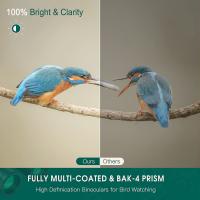How To See Microscopic Organisms ?
To see microscopic organisms, you would need to use a microscope. Microscopes are scientific instruments that magnify small objects, allowing us to observe them in detail. There are different types of microscopes, such as light microscopes and electron microscopes, each with its own capabilities and magnification levels. Light microscopes use visible light to illuminate the specimen and magnify it, while electron microscopes use a beam of electrons for imaging.
To view microscopic organisms, you would typically prepare a sample by placing it on a glass slide and covering it with a coverslip. The slide is then placed on the microscope stage, and the specimen is brought into focus by adjusting the focus knobs. By adjusting the magnification and focus, you can observe the microscopic organisms and study their structures and behaviors.
It is important to note that proper techniques and protocols should be followed when handling and preparing samples to ensure accurate observations. Additionally, some microscopic organisms may require specific staining or preparation methods to enhance their visibility under the microscope.
1、 Microscopy techniques for observing microscopic organisms
Microscopy techniques have revolutionized our understanding of the microscopic world, allowing us to observe and study microscopic organisms in great detail. To see these tiny organisms, there are several microscopy techniques that can be employed.
1. Light Microscopy: This is the most common and accessible technique used to observe microscopic organisms. It uses visible light to illuminate the specimen, and the image is magnified using lenses. Brightfield microscopy, phase contrast microscopy, and fluorescence microscopy are some variations of light microscopy that enhance contrast and provide specific information about the specimen.
2. Electron Microscopy: This technique uses a beam of electrons instead of light to visualize the specimen. Electron microscopes offer much higher resolution and magnification compared to light microscopes. Transmission electron microscopy (TEM) allows for detailed internal structure visualization, while scanning electron microscopy (SEM) provides a 3D surface view.
3. Confocal Microscopy: This technique uses laser light to scan the specimen point by point, creating a series of optical sections. These sections are then reconstructed into a 3D image, allowing for detailed examination of the specimen's structure.
4. Super-resolution Microscopy: This relatively new technique overcomes the diffraction limit of light, enabling the visualization of structures below the resolution limit of traditional light microscopy. Techniques like stimulated emission depletion (STED) microscopy and structured illumination microscopy (SIM) have revolutionized our ability to observe subcellular structures with unprecedented detail.
5. Digital Holographic Microscopy: This emerging technique records the interference pattern of light waves passing through a specimen, allowing for the reconstruction of a 3D image. It provides quantitative phase information, enabling the study of dynamic processes within living cells.
It is important to note that the choice of microscopy technique depends on the specific requirements of the study and the nature of the specimen. Advances in microscopy continue to push the boundaries of our understanding of microscopic organisms, allowing us to delve deeper into their intricate world.
2、 Types of microscopes used to view microscopic organisms
To see microscopic organisms, you can use various types of microscopes that allow for magnification and visualization of these tiny organisms. The most commonly used microscopes include light microscopes, electron microscopes, and fluorescence microscopes.
Light microscopes, also known as optical microscopes, use visible light to illuminate the specimen and magnify it. They can provide a magnification of up to 2000 times and are suitable for observing living organisms. Light microscopes are widely used in biology labs and educational settings.
Electron microscopes, on the other hand, use a beam of electrons instead of light to magnify the specimen. They offer much higher magnification and resolution compared to light microscopes, allowing for the visualization of smaller structures within the organisms. Electron microscopes are particularly useful for studying viruses, bacteria, and cellular structures. There are two types of electron microscopes: transmission electron microscopes (TEM) and scanning electron microscopes (SEM).
Fluorescence microscopes use fluorescent dyes or proteins to label specific structures or molecules within the organisms. These dyes emit light of a different color when excited by a specific wavelength of light. This technique allows for the visualization of specific components within the organisms, such as DNA or proteins. Fluorescence microscopes are commonly used in molecular biology and cell biology research.
In recent years, advancements in microscopy techniques have led to the development of super-resolution microscopes. These microscopes can surpass the diffraction limit of light, enabling the visualization of even smaller structures within microscopic organisms. Techniques such as stimulated emission depletion (STED) microscopy and structured illumination microscopy (SIM) have revolutionized the field of microscopy, allowing for unprecedented detail and resolution.
In conclusion, to see microscopic organisms, various types of microscopes can be used, including light microscopes, electron microscopes, fluorescence microscopes, and super-resolution microscopes. Each type of microscope offers different levels of magnification and resolution, allowing scientists to explore the intricate world of microscopic organisms.
3、 Sample preparation methods for observing microscopic organisms
To see microscopic organisms, you will need to use a microscope. However, before observing these organisms, proper sample preparation is crucial to ensure accurate and clear observations. Here are some sample preparation methods commonly used in microscopy:
1. Fixation: This involves preserving the organisms in their natural state by using chemicals like formaldehyde or glutaraldehyde. Fixation helps to prevent decay and maintain the structure of the organisms.
2. Staining: Stains are used to enhance the visibility of microscopic organisms. Different stains target specific components of the organisms, such as cell walls or nuclei, making them easier to observe under a microscope.
3. Mounting: After fixation and staining, the organisms are mounted on a slide using a mounting medium, such as glycerol or a synthetic resin. This helps to secure the sample and prevent movement during observation.
4. Sectioning: For larger organisms or tissues, sectioning is performed to obtain thin slices. This allows for better visualization of internal structures. Specialized equipment, such as a microtome, is used to cut the sections.
5. Culturing: In some cases, it may be necessary to culture the organisms in a laboratory setting. This involves providing the necessary nutrients and environmental conditions for the organisms to grow and multiply. Culturing allows for the observation of live organisms and their behavior.
It is important to note that advancements in microscopy techniques, such as confocal microscopy and super-resolution microscopy, have revolutionized the field. These techniques provide higher resolution and more detailed images of microscopic organisms, allowing for better understanding of their structures and functions. Additionally, the use of fluorescent probes and advanced imaging software has further enhanced the visualization and analysis of microscopic organisms.
4、 Common microscopic organisms and their characteristics
How to see microscopic organisms:
To see microscopic organisms, you will need a microscope. There are different types of microscopes available, such as compound microscopes and electron microscopes. Compound microscopes are commonly used for observing microscopic organisms. Here are the steps to see microscopic organisms using a compound microscope:
1. Prepare a microscope slide: Place a drop of water or a sample containing the microscopic organisms on a clean glass slide. Cover it with a coverslip to prevent the sample from drying out.
2. Adjust the microscope: Start with the lowest magnification objective lens and focus on the sample using the coarse and fine adjustment knobs. Once the sample is in focus, you can increase the magnification by rotating the objective lens turret.
3. Observe the sample: Look through the eyepiece and adjust the focus until the microscopic organisms come into view. Move the slide around to explore different areas of the sample.
Common microscopic organisms and their characteristics:
Microscopic organisms are diverse and can be found in various environments, including water, soil, and even inside our bodies. Some common microscopic organisms include bacteria, fungi, protozoa, and algae.
- Bacteria: These single-celled organisms are prokaryotic and can be found in various shapes (e.g., rod-shaped, spherical, spiral). They play crucial roles in nutrient cycling, decomposition, and some can cause diseases.
- Fungi: Fungi are eukaryotic organisms that include molds, yeasts, and mushrooms. They obtain nutrients by decomposing organic matter and can be found in soil, water, and on plants. Some fungi can cause infections in humans.
- Protozoa: Protozoa are single-celled eukaryotic organisms that can be found in water and soil. They move using hair-like structures called cilia or whip-like structures called flagella. Some protozoa are parasitic and can cause diseases like malaria and amoebic dysentery.
- Algae: Algae are photosynthetic organisms that can be found in aquatic environments. They can be unicellular or multicellular and come in various shapes and sizes. Algae are important for oxygen production and form the base of the food chain in many ecosystems.
It is important to note that the field of microbiology is constantly evolving, and new discoveries about microscopic organisms are being made. The latest point of view may include advancements in microscopy techniques, such as the use of fluorescent dyes to visualize specific structures within microscopic organisms or the application of advanced imaging technologies like super-resolution microscopy to achieve higher resolution and clarity in observing these organisms. Additionally, with the advent of metagenomics, researchers are now able to study the genetic material of entire microbial communities, providing a more comprehensive understanding of the diversity and functions of microscopic organisms in different environments.



























There are no comments for this blog.